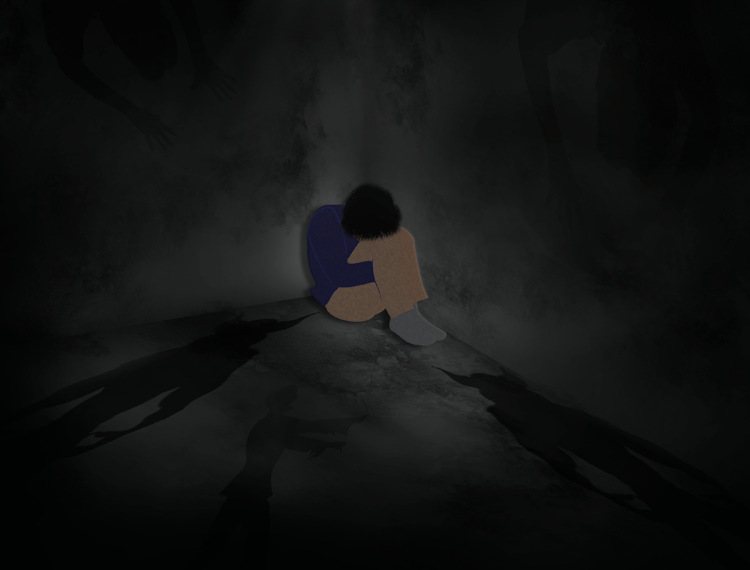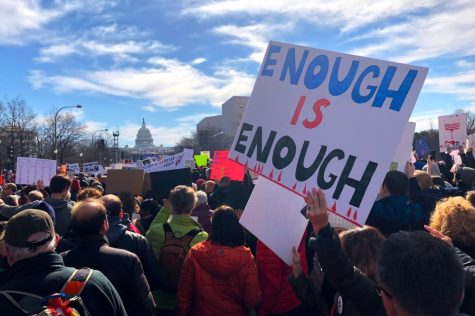Monsters in the Closet: Growing Paranoia in the U.S.
October 8, 2015
My brother and I sat in the pitch-dark basement as the light from the screen of our 50” TV flashed in our faces. Somehow he’d talked me into watching a movie that my seven-year-old self would thoroughly regret. It was about the age-old monster looming in every child’s closet and under every bed: the boogeyman. I found myself grasping my blanket tightly that night and turning my back to my closet, not daring to look.
Much like me as a young child, children now are afraid of plenty of things. They fear the dark, the creatures under their bed, and the monsters hanging out in their closets. They cower at the creepy, old, unfinished basement that sounds come from at night and the frightening nightmares that plague their minds while they sleep.
An adult would say that children fear the things that they can’t see and those which are not there. Essentially, children are afraid of absolutely nothing at all.
But let’s consider the things that adults are fearful of.
They fear thugs and thieves stealing their belongings and terrorists threatening the well-being of their country. They pray that they never have to witness their loved ones shaking with helplessness as the barrel of a gun is pressed to the side of their forehead. They are constantly worried about the imminent dangers of the world hanging over them and their families. They also believe, however, that all of these occurrences are preventable through laws and safety procedures. A lot of them.
Such procedures are taught to children a young age. From the moment each child enters kindergarten, a loud alarm will sound as every class orderly exits the building for a fire drill. Then there are other, less standardized procedures that are taught just practically, through observation. There’s a reason why we all have similar standards as to what a “suspicious” person looks like. A group of women clutched their purses just a little bit tighter as a black man passed by and thus our personal biases were formed.
The problem lies in that all of the small biases grow and develop, becoming substantial prejudices and open hatred for others. There aren’t just suspicious looking people anymore. Now all Ahmeds and Muhameds and otherwise tan-skinned, bearded men are terrorists, every man who stands in a church while the rest of the congregation sits is a potential shooter, and the black entrepreneur dressed casually for the day is suddenly a gang member. And there should be laws preventing that.
Create a law for everything. I’ve always wondered why every elementary school in my area didn’t have three or four police officers working around the clock. At least one of them should work the metal detector that searches for weapons as each ten year-old drops their Scooby Doo lunch box in a separate bin. Anyone could be a criminal, after all.
Except, in keeping up with several news sources, I’ve noticed that the number of terrorist attacks per year in the United States is virtually nonexistent. Less than five attacks tend to occur, killing much less than one hundred people. That is not to say that the attacks are not startling, but they just aren’t substantial in comparison to the hundreds of other ways people in the United States die each year.
To put it into perspective, according to the Insurance Institute for Highway Safety, in 2013, 32,719 people were killed in car crashes in the U.S. In the same year, statistics from the Center for Disease Control and Prevention state that 16,121 people in the U.S. were killed in homicides and 41,149 people died from committing suicide.
You are more likely to harm yourself than you are to be harmed by the Muslim extremist society that is lurking in your neighborhood or your coworker that has a double life as a gang banger.
Fears of mass shootings, or armed robberies, or terrorism are not unwarranted, but these events cannot be prevented. There is no magical law that will keep the evil people of the world from harboring hate and especially not from acting on it. There are no mental metal detectors that weed out the maniacal and the deranged.
We all fear the things that we cannot see and are often times not even there, but we shouldn’t allow our fears to cloud rationality. Do not make assumptions about the intentions of others. Not all accused of being suspicious are as lucky as Ahmed Mohamed, who has been offered jobs and free gifts after a digital clock that he built was mistaken for a bomb.
The apparent fears of adults are overwhelmingly like those of a child. The creaky closet door in some nine-year-old’s room is the adults front door to their house. There is no monster behind either of them.













